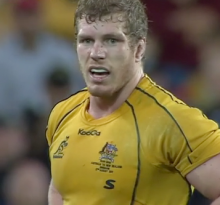The Wallabies have played vastly improved rugby in recent weeks. After their poor display when soundly defeated by New Zealand in Auckland, they have improved the fundamentals of their game significantly. This has given them the results on the scoreboard that we have all applauded.
Regular readers will know of my constant insistence on
(i) accurate support play which gives viable options to the ball-carrier and/or numbers at the tackle contest,
(ii) body-position and leg-drive which assists hugely in speed of recycle, and
(iii) urgency of realignment of our attacking line to take full advantage of this ‘quick ball’.
It looks as if the Wallabies at last understand the vital necessity of these fundamentals for proper use of their outstanding individual players. This must continue if we are to have any chance at all in the World Cup.

To make space, teams must threaten on a narrow front. Players – especially big, fast players – chasing the ball provide real threats at and around the tackle contest on ‘a narrow front’ and force the opposition to defend this area with numbers. The recent selection of both Vickerman and Samo has made this fact glaringly obvious. They have added to Moore, Horwill and Elsom in giving us world-class capability in this facet of play. Alexander and Kepu are both moving in the same direction – they have genuine ability, but still have some way to go. This will all give Pocock the chance to show his real ability – he’s playing well, but if our forwards continue in this vein, he will soon be back to his outstanding best. In forward play, “tightness is next to godliness”.
For some years now, ‘realignment’ has not been of any interest whatsoever to our team. We appeared to be far more interested in ‘loitering’. I’ve seen our wingers, for example, standing in the post position, alongside the tackle, for three consecutive tackles! Readers of Dwyer’s Video Analysis will have seen my emphasis on Conrad Smith’s simple, but urgent and vital, realignment which attracted defence and made space for Corey James’ try. Similarly, the urgent realignment of our young backline guns made the gap for Genia’s try against New Zealand in Brisbane – even though the scrambling All Black defence actually outnumbered out attack.
There are clearly other areas of our game – indeed the game of all aspiring teams – which must be executed at a high level. These are more obvious. The ball-winning plays of scrum, lineout and restarts must be secure. Our kicking game and our kick chase must give us opportunity – I commented last week on the excellence of AAC’s chase and he’s surely not the quickest of our wingers. Attitude is essential!
Over the last few weeks some readers have questioned my views on some aspects of play – and, indeed, this is their right and I applaud their comment and differing view. (I’m less than happy with those who question my view/s purely on the grounds of my “clear bias”. I do my best to avoid such motivation.) I’ve questioned the fundamental support lines of, amongst others, Scott Higginbotham, claiming that he plays far too wide of the ball-carrier in his efforts to find space.
My absolutely unaltered view is that it is the responsibility of ALL support players to provide viable options to the ball-carrier. In order to achieve this, their ultimate target must be the ball – as the ball-carrier gets closer and closer to the defence, the support player must get closer and closer to the ball. This provides for all eventualities made possible by the ball-carrier and available by the defence – early pass, off-load or assist at the eventual tackle. This makes it impossible for the support player to over-run the ball-carrier and put himself entirely out of the play. Higginbotham has some huge qualities and, if he heeds my advice, he will have many opportunities to realise them.
Quality support play from our halves will provide additional threats on the defence and will, at times, open up space for our outside backs – or gaps for Cooper and Genia. Scott Allen in a recent G&G article questioned the viability of the ‘loop play’ – a la Mark Ella and Michael Hawker of yesteryear. I would suggest that Jonny Sexton, Andrew Ellis (remember Israel Dagg’s try against the Sharks at Twickenham) and Quade Cooper (in his Reds’ mode) would heartily disagree. Some commentators also talk about the need for ‘width’ in a team’s play, but I find this term horribly misleading. Some of our Fox commentary team bang on about it incessantly.
‘Width’ alone is of NO VALUE whatsoever. In the final of the 2007 World Cup, the ball was fed along the entire Springbok backline, from the lineout to the wing, JP Pietersen. He was tackled into touch – they had achieved maximum ‘width’ – by the 7, 12, 13 & 14, with the 10 on standby if needed. My point is that the crucial ingredient of all attacking play, certainly including backline attack, is the asking of difficult questions of the defence. Shorter passes, with accurate support play – including the possibility of loops – will make space, perhaps even gaps. Long passes, including cut-outs, are simply an excuse for poor catch-pass and support skills.
Once we get our attack right, the defences will be seen for what they really are and we will all once again realise that “there is no defence to perfect attack”. John Smit’s first-half try for his Springbok “B” team against the All Black “A” team in New Zealand a few weeks back, is a telling example.
This Wallaby team has more individual players, capable of ‘winning the game’ for their team, than any other team in the tournament. It’s not enough to have great players, however. They must play great also!


